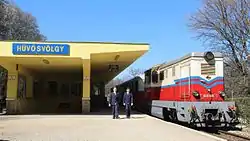Budapest Children's Railway
The Gyermekvasút (English: Children's Railway) or Line 7 is a narrow gauge railway line in Budapest, which connects Széchenyihegy and Hűvösvölgy and is 11.2 kilometres (7.0 mi) long. The former name of the line was Úttörővasút (Pioneer Railway, in reference to the communist scouts), and now the official designation is MÁV Zrt. Széchenyi-hegy Gyermekvasút. Except the train driver, all of the posts are operated by children aged 10–14[1] under adult supervision.[2] It is the world's largest children's railway.[2]
| Gyermekvasút | |
|---|---|
 | |
 | |
| Overview | |
| Status | In service |
| Owner | Hungarian State Railways (MÁV) |
| Termini |
|
| Stations | 7 |
| Website | https://gyermekvasut.hu/ |
| Service | |
| Operator(s) | Hungarian State Railways (MÁV) |
| History | |
| Opened | 1948-1950 |
| Technical | |
| Track length | 11.2 km (7.0 mi) |
| Track gauge | 760 mm (2 ft 5+15⁄16 in) |
| Operating speed | 20 km/h (12 mph) |
Budapest Children's Railway | ||||||||||||||||||||||||||||||||||||||||||||||||||||||||||||||||||||||||||||||||||||||||||||||||||||||||||||||||||||||||||||||||||||||||||||||||||||
|---|---|---|---|---|---|---|---|---|---|---|---|---|---|---|---|---|---|---|---|---|---|---|---|---|---|---|---|---|---|---|---|---|---|---|---|---|---|---|---|---|---|---|---|---|---|---|---|---|---|---|---|---|---|---|---|---|---|---|---|---|---|---|---|---|---|---|---|---|---|---|---|---|---|---|---|---|---|---|---|---|---|---|---|---|---|---|---|---|---|---|---|---|---|---|---|---|---|---|---|---|---|---|---|---|---|---|---|---|---|---|---|---|---|---|---|---|---|---|---|---|---|---|---|---|---|---|---|---|---|---|---|---|---|---|---|---|---|---|---|---|---|---|---|---|---|---|---|---|
| ||||||||||||||||||||||||||||||||||||||||||||||||||||||||||||||||||||||||||||||||||||||||||||||||||||||||||||||||||||||||||||||||||||||||||||||||||||
The Széchenyihegy terminus of the Gyermekvasút is a 250-metre (820 ft) walk from the upper terminus of the Budapest Cog Railway, whilst the Hűvösvölgy terminus is adjacent to the Budapest tram terminus of the same name.
History
In 1947, the Hungarian State Railways (MÁV) company decided that a railway operated by children would be built. For the railway construction several sites were considered, including the neighbourhood of the Gödöllő Palace, Margaret Island, and the Népliget, but finally in 1948 the Hungarian Communist Party chose the Buda Hills. The construction started on 11 April 1948.
The first section, from Széchenyi-hegy to Előre station (now Virágvölgy) was inaugurated on 31 July 1948. The second section, to Szépjuhászné station (now Szépjuhászné), was completed one year later, and the last section, to Hűvösvölgy, was opened on 20 August 1950.[3]
During the Hungarian Revolution of 1956 the railway was closed but was not damaged. It reopened on 3 February 1957.[4]
A museum at Hűvösvölgy station displays some items from the Communist period.[5]
References
- "Children's Railway". Lonely Planet.
- "Introduction". Children's Railway. Archived from the original on 2 July 2013. Retrieved 11 November 2011.
- "Part 6: The third section". Children's Railway.
- "Part 7: First decade of operation". Children's Railway.
- "Children's Railway". visitbudapest.travel. Archived from the original on 3 February 2020.
External links
- Official website
 Media related to Gyermekvasút at Wikimedia Commons
Media related to Gyermekvasút at Wikimedia Commons